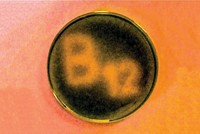Advertisement
Grab your lab coat. Let's get started
Welcome!
Welcome!
Create an account below to get 6 C&EN articles per month, receive newsletters and more - all free.
It seems this is your first time logging in online. Please enter the following information to continue.
As an ACS member you automatically get access to this site. All we need is few more details to create your reading experience.
Not you? Sign in with a different account.
Not you? Sign in with a different account.
ERROR 1
ERROR 1
ERROR 2
ERROR 2
ERROR 2
ERROR 2
ERROR 2
Password and Confirm password must match.
If you have an ACS member number, please enter it here so we can link this account to your membership. (optional)
ERROR 2
ACS values your privacy. By submitting your information, you are gaining access to C&EN and subscribing to our weekly newsletter. We use the information you provide to make your reading experience better, and we will never sell your data to third party members.
Synthesis
Glowing Green
A new role for a now-famous fluorescent protein
by Sarah Everts
April 27, 2009

The discovery and development of green fluorescent protein (GFP) as a tool for biomedical research was the basis for last year's Nobel Prize in Chemistry, but the protein's biological role in a cell has long been the source of debate. Now researchers are reporting that GFP may act as a light-induced electron donor (Nat. Chem. Biol., DOI: 10.1038/nchembio.174), a function that suggests new applications for the protein.
A team of researchers led by Konstantin and Sergey Lukyanov at the Shemyakin-Ovchinnikov Institute of Bioorganic Chemistry, in Moscow, found that GFPs isolated from a variety of creatures, including jellyfish and sea anemones, could donate two electrons to a variety of acceptors found in biological cells during photochemical reactions. This electron donation causes the light emitted by the protein to change from green to red.
"It's a completely unexpected twist on the effects of proteins that everybody has been working with for more than a decade," comments Mikhail V. Matz, who studies biofluorescence at the University of Texas, Austin.
The researchers propose that the protein, which is already ubiquitous in laboratories, can be newly applied to monitor redox reactions or the proximity of GFP to an electron acceptor. The new functionality adds to other suggested roles for GFP, including oxygen radical scavenging and photoprotection.




Join the conversation
Contact the reporter
Submit a Letter to the Editor for publication
Engage with us on Twitter